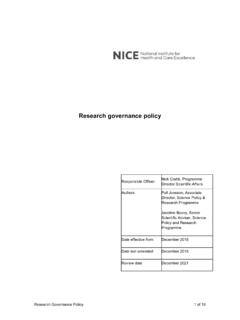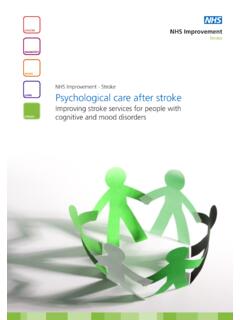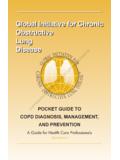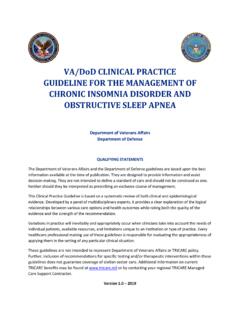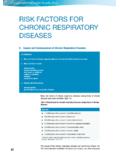Transcription of 729 Re-audit of Chronic Obstructive Pulmonary Disease (COPD)
1 729 Re-audit of Chronic Obstructive Pulmonary Disease (COPD) A Re-audit against NICE CG101 for patients on the domiciliary and community hospital caseload of the LPT COPD Specialist Nurse Team Karen Moore Respiratory Specialist Nurse (Team Lead) Jayshree Raval, NICE & Effectiveness Officer Zoe Harris Specilaist Nurses Manager Audit Period: June 2013 August 2013 Report Date: August 2013 Contents Page Page Contents .. 2 Abbreviations 2 Executive Summary .. 3 Why the audit was undertaken 3 Aims and objectives 5 Thresholds of compliance .. 6 Method .. 6 Audit type 6 Service areas / teams included 6 Audit findings .. 7 How compliance was 9 Comments .. 10 Areas of good practice 10 The results had improved across the board in every category. 10 Areas for improvement/Recommendations 10 Lessons learnt 11 References .. 11 Appendix 1 Audit tool .. 12 Appendix 2 Distribution 14 Appendix 3 Action plan(Actions completed from the baseline audit) .. 15 Appendix 4 Action plan (following Re-audit ).
2 16 Abbreviations LPT Leicestershire Partnership NHS Trust LLR Leicester, Leicestershire and Rutland COPD Chronic Obstructive Pulmonary Disorder NICE National Institute of Health & Care Excellence CHS Community Health Service NHSLA National Health Service Litigation Authority DH Department of Health PSEG Patient Safety & Experience Group SCQG Senior Clinical Quality Group CAEG Divisional Clinical Audit & Effectiveness Groups LTC Long Term Condition COPD Re-audit Page 3 Executive Summary Why the audit was undertaken The Re-audit was undertaken to establish if the changes listed in the action plan following the baseline audit in January 2013 had led to improvements in the care given to people with COPD on the caseload of the respiratory specialist nurse service. This is a part of (West) Community Health Services Division. The NICE COPD (CG101) 2010 guidelines were used to establish best practice for delivering COPD care. How the audit was carried out The Re-audit has been conducted to establish current practice following the implementation of the action plan which was formulated following the baseline audit.
3 It has involved a retrospective case note review of 78 electronic patient records out of a whole population size of 300 from six respiratory specialist nurses. Only patients that had been referred onto the caseload from March 2013 were reviewed. The sample was evenly split across all six nurses. The sample was taken randomly from each nurse s community hospital and domiciliary caseload; the date of the initial referral was checked for each patient to ensure they had been added to the caseload in the given period, this was done to ensure that patients included in the baseline audit were not used again and also to allow time for the steps in the action plan to be implemented. The agreed action plan (appendix 3) included: 1. Improving the systm1 templates to ensure that the assessment questions are clear within the template 2. Improving history taking, an education session was delivered to the team by a respiratory Consultant from UHL 3.
4 Improving record keeping and documentation by completing spot check notes audits 4. To ensure enough time was allowed during appointment for accurate record keeping; by increasing first appointments from sixty minutes to ninety minutes slots. 5. A crib sheet has been developed as a prompt to ensure that all relevant information is gathered. 6. Finally, increasing the number of patients referred to Pulmonary rehabilitation by adding a prompt for this below the MRC score section in the template As with the first audit the sections within the NICE guidance that were related to medicines management were not included as the patient s general practitioner has the continuing responsibility for this. Those parts relating to spirometry and diagnosis were also omitted as the service is commissioned for those patients who have an existing diagnosis of COPD. Thirteen notes were examined from each of the six nurses. Every set of notes was audited against the documentation audit tool (see appendix 1).
5 The tool was developed using the recommendations from the COPD NICE guidance (CG101).The Respiratory Specialist Nurse Team Lead collected the data on three consecutive dates from the 25th to 28th of June. The information was collected from the journal of the electronic patient notes on Systm1. This was a retrospective case note review of 78 electronic patient records out of a whole population size of 300 from six respiratory specialist nurses COPD Re-audit Page 4 Criteria 2011/12 Compliance 2012/13 Compliance / 1. Is the patient being assessed for COPD? 99% 100% 1% 2. Has patient with COPD on the 1st assessment, been asked about the presence of the following factors by the respiratory nurse? a) weight loss? 35% 91% 56% b) effort intolerance? 81% 99% 18% c) waking at night? 19% 65% 46% d) ankle swelling? 58% 97% 39% e) fatigue? 35% 78% 43% f) Occupational hazards? 45% 78% 33% g) Chest pain? 17% 91% 74% h) haemoptysis? 19% 95% 76% 3.
6 Was the MRC dyspnoea scale used to grade breathlessness according to the level of exertion required to elicit it? 86% 99% 13% 4. Have patients with an MRC score of 3, 4 or 5 been offered a referral to Pulmonary rehabilitation? 50% 80% 30% 5. Has pulse oximetry been recorded to assess the need for oxygen? 97% 100% 3% 6. Is there an up to date smoking history for the patient? 77% 99% 23% a) Smoker 18% b) Ex-Smoker 75% c) Non-Smoker 6% 7 & 8 Does it include smoking pack years? 30% 78% a) Smoker 71% b) Ex-Smoker 79% 9. If the patients is planning to stop smoking, have they been referred to smoking cessation services Making Every Contact Count (MECC)? 1% 100% 99% 10. Has the patient been given a personalised care plan which includes a self-management plan for exacerbations? 79% 100% 21% COPD Re-audit Page 5 Background Aims and objectives Chronic Obstructive Pulmonary Disease (COPD) is characterised by airflow obstruction that is progressive, not reversible and does not change markedly over several months.
7 It is predominantly caused by smoking. COPD kills 25,000 people a year in England and Wales and is the fifth biggest killer in the UK NICE (2010). COPD has been highlighted as a priority area by the local health community within the outline document: A five year plan to improve COPD care in Leicestershire, it causes significant morbidity, unscheduled admissions and readmissions and there is variability in the care delivered in primary and secondary care. The respiratory specialist nurses in Leicestershire Partnership Trust (LPT) provide a specialist service in the community within Leicester, Leicestershire and Rutland (LLR) for patients diagnosed with COPD. The purpose of the service is to improve quality of life, avoid unnecessary admissions and reduce length of stay in accordance with NICE guidance (CG101) and locally agreed pathways. Objective five within the Department of Health COPD Outcomes Strategy (2011) states that people with COPD should receive safe and effective care which minimises Disease progression enhances recovery and promotes independence.
8 The aim of this audit is to measure the current practice within the LPT team in the diagnosis and management of COPD against the recommendations in NICE guidance. The objectives are: To determine if appropriate patients are being assessed by the nurses. To examine the initial assessment to ensure a full history has been taken and that alternative diagnoses have been ruled out To determine if a course of Pulmonary rehabilitation has been offered to patients who are functionally disabled by their COPD To determine if patients have been assessed for the need for oxygen therapy To examine if patients have been encouraged to stop smoking To determine if the patients are being encouraged to manage exacerbations with the utilisation of self-management advice on responding promptly to exacerbations. This is in the form of a personalised care plan. Criteria & standards The following criteria and standards were set using the recommendations from the NICE guidance (CG101): Table 1 - Criteria and standards Criteria Standard Evidence base At first assessment all patients should be asked about weight loss 100% NICE guidance At first assessment all patients should be asked about effort intolerance 100% NICE guidance At first assessment all patients should be asked about waking at night 100% NICE guidance At first assessment all patients should be asked about ankle swelling 100% NICE guidance At first assessment all patients should be asked about fatigue 100% NICE guidance At first assessment all patients should be asked about occupational hazards 100% NICE guidance At first assessment all patients should be asked about chest pain 100% NICE guidance At first assessment all patients should be asked about haemoptysis 100% NICE guidance The MRC dyspnoea scale should be used to grade breathlessness 100% NICE guidance Patients with an MRC score of 3.
9 4 or 5 are offered a referral to Pulmonary rehabilitation 80% NICE guidance COPD Re-audit Page 6 Criteria Standard Evidence base Pulse Oximetry is recorded to assess the need for oxygen therapy 100% NICE guidance An up to date smoking history has been documented in the patients record which includes if the patient is a current smoker, ex-smoker or non-smoker 100% NICE guidance The number of pack years smoked has been documented (number of cigarettes smoked a day/ 20 X number of years smoked) 100% NICE guidance Patients who wish to stop smoking are offered a referral to smoking cessation services (MECC) 100% NICE guidance A personalised care plan which includes a self-management plan for exacerbations is offered to all patients 100% NICE guidance NB, the inclusion criteria is that all patients must have a diagnosis of COPD Normally the standards for all criteria are set at 100% for NICE guidance audits. However, as there are patients on each caseload who do not meet the inclusion criteria for Pulmonary rehabilitation, the standard for referring patients with an MRC of 3, 4 or 5 has been set at 80%.
10 Thresholds of compliance Key: Full compliance 90% 100% Partial compliance 70% <89% Minimal compliance < 69% Method The Re-audit has been conducted to establish if the action plan had improved practice and involved a retrospective case note review of 78 electronic patient records out of a whole population size of 300 from six respiratory specialist nurses. The sample is to a confidence level of 95% (+/- 10%). Only patients that had been on the caseload since March 2013 were reviewed. The sample was evenly split across all six nurses. The sample was taken randomly from each nurse s domiciliary and community hospital caseload; the date of the initial referral was checked for each patient to ensure they had been added to the caseload from March 2013. This was done to ensure that patients had not been included in the first audit and also to allow time for the steps in the action plan to be implemented. Thirteen notes were examined from the six nurses.

